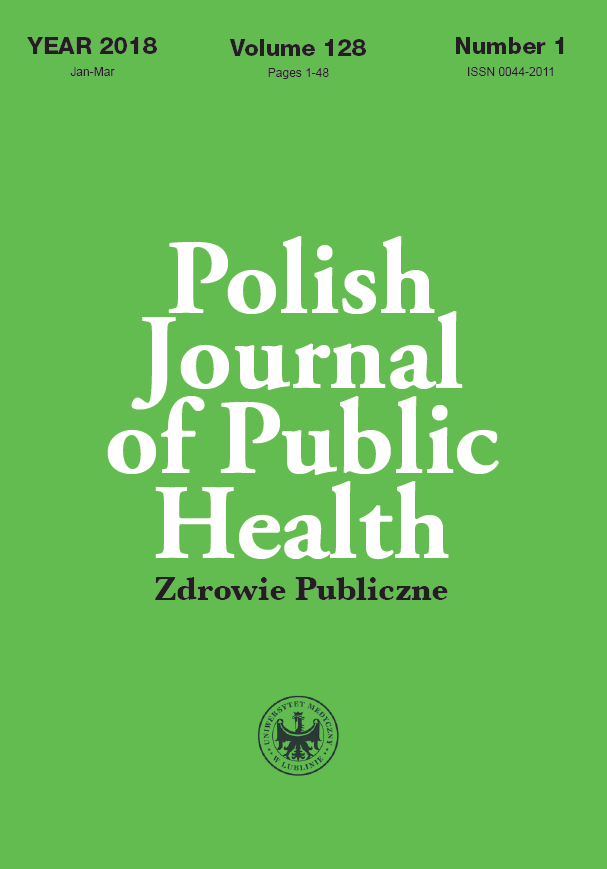Nutritive value of chosen special purpose dietary products
DOI:
https://doi.org/10.2478/pjph-2018-0003Keywords:
foodstuffs of special medical use, dietary supplements, food monitoringAbstract
Introduction. Foodstuffs of special nutritional use and dietary supplements, especially in the case of sportsmen, have been known and widely used in human nutrition, nourishment, and convalescence for many years.
Aim. The aim of the study was to assess the nutritional value of two groups of special dietary formulations and, in particular, to compare the nutrient and energy content declared by producers with that revealed by the present analyses.
Material and methods. The nutritional value of two groups of formulations was assessed. The first group comprised formulations for undernourished subjects or those with contraindications to use diets with normal content of proteins and/or fats. The second group of formulations included products intended for strengthening the organism and targeted mainly at sportsmen. Samples of purchased products were analyzed for the content of basic components: dry matter, total protein, crude fat, crude ash, and structural carbohydrates. The content of carbohydrates and energy value was calculated mathematically. Additionally, the content of selected minerals (calcium, potassium, sodium, magnesium, iron, zinc, copper, manganese) was determined.
Results. The content of carbohydrates, proteins, and especially fat in the chemical composition of the analyzed products declared by the producers differed from the levels determined in this study. In the mineral composition, differences were noted in the content of macroelements, while the content of micronutrients did not differ from the declared values. Despite the differences in the composition, the declared and calculated calorific values in all formulations were similar.
Conclusions. There were differences between the declared and determined contents of nutrients in the analyzed formulations. The labels of the special-purpose industrial formulations purchased in pharmacies provided more information about their composition and nutritional value, whereas the information presented on the labels of the athlete supplements were less informative. Consumption of the supplements, in particular those dedicated for sportsmen, should be supervised by a doctor or dietitian
References
1. Rozporządzenie Parlamentu Europejskiego i Rady (UE) nr 609/2013 z dnia 12 czerwca 2013 r.
2. AOAC. Official methods of analysis of the association of official chemists. 17th Edition. AOAC, Arlington 2011.
3. Gawęcki J. Żywienie człowieka. Podstawy nauki o żywieniu. PWN, Warszawa 1998.
4. Kotara T. Podstawy żywienia klinicznego. Warszawa: Wydawnictwo Lekarskie PZWL; 2008.
5. Jarosz. M. Praktyczny podręcznik dietetyki. Warszawa: Instytut Żywności i Żywienia; 2010.
6. Dobrzyńska E, Frydecka D. Jadłowstręt psychiczny (anorexia nervosa) – etiologia, obraz kliniczny, rozpoznawanie, leczenie. Gab Pryw. 2006;149(4):51-64.
7. Raczyńska M. Żywienie dojelitowe u dzieci leczonych chirurgicznie. Przydatność preparatów firmy Ovita Nutricia. Postępy Med Klin Dosw. 1997;6(2):129-35.
8. Ziemlański Ś. Odżywki dla sportowców i innych osób obciążonych dużym wysiłkiem fizycznym. Now Med. 1996;3:39-42.
9. Hubner-Woźniak E, Lutosławska G. Podstawy biochemii wysiłku fizycznego. Warszawa: COS; 2000.
10. Bączkowicz M, Fortuna T, Ogonek J. Jakość odżywek białkowo-węglowodanowych i preferencje konsumenckie osób o zwiększonej aktywności fizycznej. ŻYWNOŚĆ. Nauka. Technologia. Jakość. 2007;6 (55):268-76.
11. Stefan M, Pasiakos T, McLellan M, Lieberman HR. The effects of protein supplements on muscle mass, strength, and aerobic and anaerobic power in healthy adults: a systematic review. Sports Med. 2015;45(1):111-31.
12. Gibala MJ. Protein metabolism and endurance exercise. Sports Med. 2007;37:337-40.
13. Goulet O. Interwencje żywieniowe u niedożywionych dzieci. Stand Med. 2004;3:322-32.
14. Williams MH. Dietary supplements and sports performance: minerals. J Int Soc Sports Nutr. 2005;2(1):43-9.
15. Knapik JJ, Steelman RA, Hoedebecke SS, et al. Prevalence of dietary supplement use by athletes: systematic review and meta-analysis. Sports Med. 2016;46(1):103-23.
Downloads
Published
Issue
Section
License
Copyright (c) 2018 Polish Journal of Public Health

This work is licensed under a Creative Commons Attribution-NonCommercial-NoDerivatives 3.0 Unported License.


